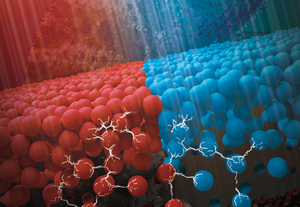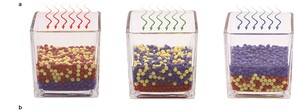

The illustration shows how different coloured lights can cause different layers to form in a mixture of tiny particles. Each colour of light creates a unique pattern of vertical separation in the mixture. Images adapted from the journal paper.
 Lead Researcher // Professor Jinyao TANG, Associate Professor of the Department of Chemistry
Lead Researcher // Professor Jinyao TANG, Associate Professor of the Department of ChemistryCollaborators // The Hong Kong University of Science and Technology and the University of Electronic Science and Technology of China
Cephalopods, like squids and octopuses, can change their skin colour to match their environment, acting as natural camouflage. This colour transformation occurs as tiny pigment particles in their skin move with muscle flexing. Inspired by this natural phenomenon, our team crafted a photochromic Active Colloids ink that mimics cephalopod colour-changing abilities.
Rather than creating new colours, they used light to reposition existing pigments within the ink. By combining various coloured microscopic beads, they created a light-responsive colour display — essentially, painting with light.
Rather than creating new colours, they used light to reposition existing pigments within the ink. By combining various coloured microscopic beads, they created a light-responsive colour display — essentially, painting with light.
This advancement heralds new possibilities for dynamic colour displays and adaptive materials. Beyond just changing colours, it holds promise for creating light-sensitive micro-robots that can be controlled by adjusting the type and intensity of light. These robots can either gather or scatter as required, allowing them to adapt to different environments and tasks.
我們的研究團隊開發了一種新型的活性膠體材料,可通過混合青色、洋紅色和黃色膠體,形成動態的納米糰,並通 過控制光線的入射波長和強度來控制膠體的運動和相互作用,從而產生不同的顏色。這種新的技術比傳統的變色材料更加可靠和便利。
Journal paper: Photochromism from wavelength-selective colloidal phase segregation (published in Nature, 2023)
| < Previous | Next > |

